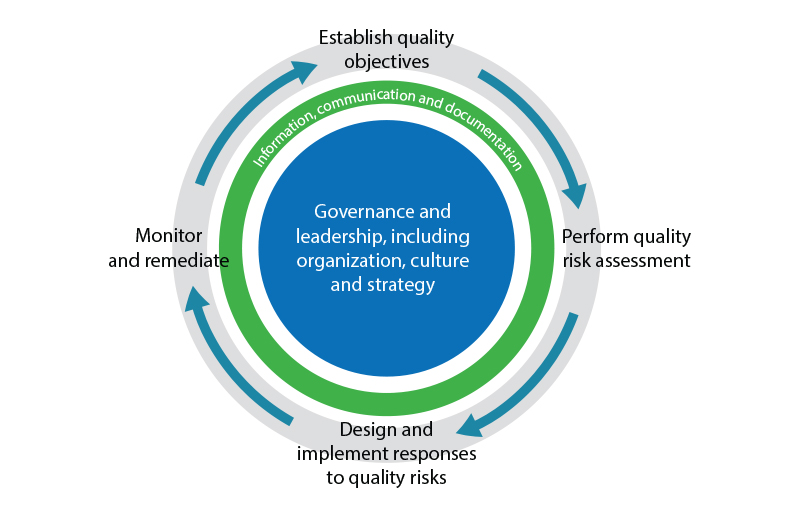
IAASB webinar: A window into quality control changes
The need to strengthen the consistency of audit quality across a firm’s audit base has been a focus of global inspection reports, including in Canada. A recent webinar presented by the International Auditing and Assurance Standards Board (IAASB) provided a status report on the IAASB’s project to enhance quality control for firms. The Quality Management Approach (QMA) will drive changes designed to encourage quality management at the firm and engagement levels. The QMA is fostered by proactive firm leadership and management, and reinforced by a firm’s culture and strategy.
What is the QMA?
The QMA is intended to be a risk-based and scalable approach to managing quality as illustrated in the diagram below:

The engine that drives the approach is the Quality Management Process (QMP). The QMP requires firms to:
- establish quality objectives
- identify and assess quality risks
- design and implement responses to those risks
- monitor and remediate as appropriate
How is this different from existing standards?
The existing standards focus on policies and procedures and many see these as checklist-based, not scalable, and not driving quality from the top down. The QMA is expected to result in a more proactive focus on quality using a tailored approach that focuses on risk.
What can we expect to see the project address?
The project intends to address matters such as:
- the scalability of the QMA for small and medium practices
- alternative delivery models such as shared service centres
- how the QMA works for networks and others involved in the audit such as component auditors
- the responsibilities of the engagement partner
The extant quality control standard contains requirements and application material for engagement quality control reviews (EQCR ). The IAASB is working on a new, separate standard on EQCR, setting out who is eligible to be a reviewer, and how to perform and document an EQCR. The IAASB believes that the QMA will be more scalable if the new standard is clear that the firm can identify responses other than an EQCR as the appropriate response to quality risks, and by having a separate standard to be applied when an EQCR is to be performed.
Appropriate linkages also need to be drawn between quality management at the firm level and quality management at the engagement level. For example, responses to quality risks identified at the firm level will need to be designed and implemented at the engagement level.
Where are key issues likely to emerge?
While the QMA approach shows promise because of its risk-based approach, the following are some potential issues that may arise during the course of this project that may be of particular relevance to Canadian practitioners:
- How scalable will the QMA be for smaller and medium practices? In my view, the IAASB should field test the QMA across a range of firms to see if it is, in fact, broadly operational. It would be problematic if there are requirements around governance and leadership, for example, or prescribed responses to quality risks, that cannot be appropriately addressed in the context of a small practice.
- The international standard is applicable to audits and other assurance and related service engagements. Canada’s quality control standard excludes related services engagements from its scope. Will the QMA be adaptable beyond assurance engagements, for example, to agreed-upon procedures and compilations engagements, so that it can be fully adopted in Canada?
- Will the QMA approach address the concern with the existing standard’s requirements dealing with monitoring and cyclical inspection of files? Many smaller firms have difficulty finding a suitably qualified external person to perform engagement inspections and other monitoring procedures.
- Will documentation requirements for the QMA set a reasonable threshold – documentation of the operation of the QMA that is not overly burdensome for small and medium practices? Clear articulation of the objectives and expectations of documentation may be required.
Keep the conversation going
As the IAASB moves forward with its project, I would like to hear your views on these and other issues. But, first of all, what do you think about the quality management approach outlined in the webinar?
Post a comment below; or email me directly.
Conversations about Audit Quality is designed to create an exchange of ideas on global audit quality developments and issues and their impact in Canada.